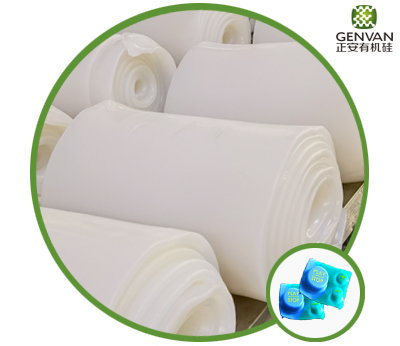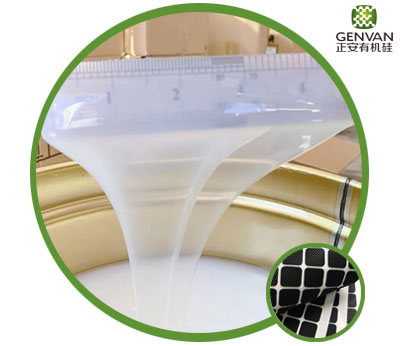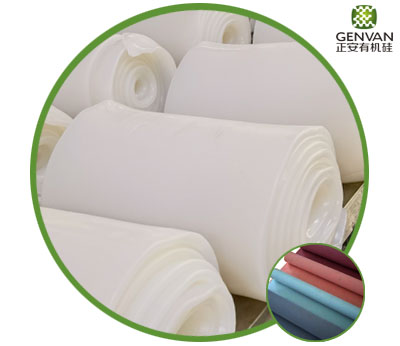The Difference Between Food-Grade Silicone and Regular Silicone
As food safety issues are increasingly being emphasized and the pandemic has drastically changed people's eating habits, more and more silicone eco-friendly tableware packaging bags are appearing on the market to replace disposable plastic products. Although in previous articles we have emphasized the non-toxic and safe characteristics of silicone, specific product usage and related certification procedures will still use different ingredients for production. Today, let's talk about the differences between food-grade silicone and ordinary silicone.
Food-grade silicone refers to being edible? Of course not. It is important to reiterate that silicone is, in general, safe, non-toxic, and harmless to the human body as a raw material. However, it can still be distinguished into food-grade and ordinary grade. Food-grade liquid silicone refers to all products that come into contact with our food, such as baby pacifiers, straws, food containers, utensils, and more. Ordinary silicone is generally used for industrial purposes and cannot be used for these types of food-related products. The main differences between food-grade silicone and ordinary silicone are as follows:
The manufacturing methods and procedures of food-grade liquid silicone and ordinary silicone
Food-grade liquid silicone generally selects high-quality raw materials, and the quality of the materials has already been determined when selecting the raw materials. Therefore, quality inspection reports are essential when procuring raw materials. This does not mean that the quality of ordinary silicone is not good, but rather that there are different application areas between the two. Ordinary silicone products are made by blending ordinary silicone, while high-quality food-grade products are made using food-grade gas-phase silicone. As we know, silica is one of the main components of silicone, and the purity and density of gas-phase silica are higher than that of ordinary silica. Therefore, the difference can be seen in the finished product, mainly in terms of tensile strength. Food-grade liquid silicone rubber has a reinforcing effect on the tensile properties, so whitening phenomena will not appear during the stretching process. Therefore, to preliminarily identify whether a silicone product is food-grade, judgment can be made based on this point.
The composition of food-grade liquid silicone and ordinary silicone
Silicone used for food is an inorganic polymer colloidal material that is made by condensing silicic acid. It is non-toxic and tasteless, chemically stable, and under normal conditions, it does not react with any acid, alkali, or salt except for caustic soda and hydrofluoric acid. It can withstand temperatures up to 220°C, so it can be used in a microwave oven without any effect on the human body. Compared to other materials, it has the characteristics of being safer and healthier. Food-grade liquid silicone rubber has strong stability and is more suitable for healthy and safe living.
The certification of food-grade liquid silicone and ordinary silicone
Products made from food-grade liquid silicone rubber are silicone products processed from food-grade silicone rubber raw materials. According to market demand, it needs to meet environmental testing requirements.
We believe that in many industries, the importance of material selection has a certain impact on the quality and performance of the product. The raw materials used for Zhejiang Zheng'an Silicone Co., Ltd. are compliant with regulations and are backed by material property tables and related testing reports. If you have any problems or needs, please come to Zheng'an!
Popular Silicone Rubber Products
-
HTV Silicone Rubber
-
General HTV
- General Purpose Silicone Rubber For Molding (Precipitated/Fumed)
- High Strength Silicone Rubber
- Highly Anti-yellowing Silicone Rubber (Precipitated/Fumed)
- High Tear Strength Silicone Rubber for Molding (Precipitated/Fumed)
- High Resilience Fumed Silicone Rubber
- High-Transparent Fumed Silicone Rubber
- General Purpose Silicone Rubber For Extrusion (Precipitated/Fumed)
-
Advanced HTV
- High Hardness Silicone Rubber
- Low Hardness Silicone Rubber
- 2mm Flame Retardant Silicone Rubber
- High Strength Flame Retardant Silicone Rubber
- Flame Retardant Silicone Rubber (1mm: UL Yellow Card Cetificated)
- Silicone Rubber For Green Car
- Silicone Rubber for Cable Accessories (DBPMH/Platinum)
- Platinum Catalyzed Silicone Rubber For Extrusion
- Platinum Catalyzed Silicone Rubber For Molding
- Platinum Catalyzed Silicone Rubber for Medical Products
- Long Service Life Silicone Rubber for Buttons
- Antistatic Silicone Rubber (Precipitated/Fumed)
- Antistatic Silicone Rubber (Natural Color/Black)
- Oil-bleeding Silicone Rubber (Precipitated/Fumed)
- Thermally Conductive Silicone Rubber
- Oil Resistant Silicone Rubber
- Low Compression Set Silicone Rubber (Precipitated/Fumed)
- Heat Resistant Silicone Rubber (250 and 300 centigrade Degree)
- Hot Stamping Roll Silicone Rubber
- Heat Resistant and Flame Retardant Silicone Rubber
- Antibacterial silicone rubber (Precipitated/Fumed)
- GA-6071AHT series of Heat Cure Rubber (HCR)
-
General HTV
-
LIQUID SILICONE RUBBER
- General LSR
-
Advanced LSR
- Non-post-curing Liquid Silicone Rubber
- Liquid Silicone Rubber For Cable Accessories
- Selective Self-Adhesive Liquid Silocone Rubber
- Low Viscosity Liquid Silicone Rubber
- Optical Liquid Silicone Rubber
- Self-Lubricating Liquid Silicone Rubber
- Liquid Silicone Rubber For Molding
- Liquid Silicone Rubber For Medical
- Liquid Silicone Rubber For Coating
- Antibacterial Liquid Silicone Rubber
- GA-23 Series Liquid Silicone Rubber
-
- What Is LSR?
-
Genvan liquid silicone rubber
Generate your Vantage - Making a Powerful Debut | GENVAN Silicone Participates in K SHOW 2025 - International Trade Fair for Plastics and Rubber (Germany)
- Home
- Company Profile
- FAQ
- HTV Silicone Rubber
- Clear Liquid Silicone Rubber
- Industrial
- General Purpose Silicone Rubber For Molding Fumed
- What Is HCR?
- “Scientific and technological innovation won the award again -- Genvan Silicone was recognized as "China's fluorine silicon industry innovative Enterprise"
- GENVAN Liquid silicone rubber factory
- Products
- Medical
- Document Download
- LIQUID SILICONE RUBBER
- High Strength Liquid Silicone Rubber
- HTV Silicone Rubber
- General Purpose Silicone Rubber For Molding Precipitated
- Genvan Is One Of The Raw Material Manufacturers Of Bing Dwen Dwen
- Silicone Innovation
- Genvan product introduction - pad printing liquid silicone rubber
- About Us
- Automotive
- Blog
- General Purpose Liquid Silicone Rubber (Precipitated/Fumed)
- High Strength Silicone Rubber
- Liquid Silicone Rubber
- Wide Application Of Silicone Products In The Medical Industry
- Join with EP Power Show to create a new engine for the industry
- Applications
- Electronics
- Silicones Wiki
- Liquid Silicone Rubber For Baby Care
- High-Anti-Yellowing Silicone Rubber Fumed
- LSR Liquid Silicone Rubber
- Happy Women's Day
- Method For Improving Heat Resistance And Flame Retardancy Of Silicone Rubber
- Company News
- Resources
- Domestic Products
- Video
- General Purpose Silicone Rubber For Molding (Precipitated/Fumed)
- Non-post-curing Liquid Silicone Rubber
- High-Anti-Yellowing Silicone Rubber Precipitated
- LSR Liquid Silicone
- 8 Reasons Why Silicone Rubber is the Best Material for Medical Device Design
- Dongguan Genvan Silicone Technology Co., LTD., subsidiary of Genvan Group, wins the title of National SRDI "Little Giant" Enterprise!
- Contact Us
- Quality Control
- High Strength Silicone Rubber
- Liquid Silicone Rubber For Cable Accessories
- High Tear Strength Silicone Rubber for molding Fumed
- 2022, Genvan Will Build Dreams Of The Future!
- Silicone Rubber Company Video
- Composition of Silicone Rubber | Main Features and Uses of Silicone Rubber Products
- Search Result
- Highly Anti-yellowing Silicone Rubber (Precipitated/Fumed)
- Selective Self-Adhesive Liquid Silocone Rubber
- High Tear Strength Silicone Rubber for molding Precipitated
- Silicone Rubber Factory Video
- Processing Technology of Silicone Rubber
- Genvan Silicone attends the Honai International Maternity, Baby & Kids Fair
- Low Viscosity Liquid Silicone Rubber
- Search Result Products
- High Resilience Fumed Silicone Rubber
- Silicone Rubber Manufacturer Video
- Different Grades of Silicone Rubber Products | Why Do Many People Choose Medical Grade Silicone?
- Continuing to Expand Globally to Serve Clients and Planting the Seeds for Mutual Success in 2025
- High Tear Strength Silicone Rubber for Molding (Precipitated/Fumed)
- Optical Liquid Silicone Rubber
- Search Result Others
- High-Transparent Fumed Silicone Rubber Fumed
- Silicone Rubber Supplier Video
- How to Distinguish Ordinary Silicone and Platinum Silicone Products?
- Joyful Journey | Review of GENVAN Silicone 2025 Annual Travel Activity
- Sitemap
- High Resilience Fumed Silicone Rubber
- Self-Lubricating Liquid Silicone Rubber
- General Purpose Silicone Rubber For Extrusion Fumed
- The Difference Between Food Grade and Medical Grade Silicone
- Genvan Silicone
- 404
- High-Transparent Fumed Silicone Rubber
- Liquid Silicone Rubber For Molding
- General Purpose Silicone Rubber For Extrusion Precipitated
- Safety Performance of Medical Silicone
- Privacy Policy
- General Purpose Silicone Rubber For Extrusion (Precipitated/Fumed)
- Liquid Silicone Rubber For Medical
- High Hardness Silicone Rubber
- What is Liquid Silicone?
- Submission Successful!
- High Hardness Silicone Rubber
- Liquid Silicone Rubber For Coating
- Low Hardness Silicone Rubber
- What Are the Main Factors That Affect the Surface Stickiness of Silicone Products?
- Taggg
- Low Hardness Silicone Rubber
- Antibacterial Liquid Silicone Rubber
- 2mm Flame Retardant Silicone Rubber
- Four Characteristics of High Temperature Cables
- GA-23 Series Liquid Silicone Rubber
- 2mm Flame Retardant Silicone Rubber
- High Strength Flame Retardant Silicone Rubber
- What Are the Applications and Functions of Silicone Rubber Products in the Automotive Industry?
- High Strength Flame Retardant Silicone Rubber
- Flame Retardant Silicone Rubber (1mm, UL Yellow Card Cetificated)
- Why Are Silicone Products So Popular?
- Flame Retardant Silicone Rubber (1mm: UL Yellow Card Cetificated)
- Silicone Rubber For Cable Accessories
- What Are the Differences between Liquid Silicone and Solid Silicone?
- Silicone Rubber For Green Car
- What Are the Definitions of Medical Silicone Materials?
- Silicone Rubber for Cable Accessories (DBPMH/Platinum)
- Platinum Catalyzed Silicone Rubber For Extrusion
- Application of Silicone Rubber Products in Various Industries
- Platinum Catalyzed Silicone Rubber For Extrusion
- Platinum Catalyzed Silicone Rubber For Molding
- Analysis of Reasons for Yellowing of Transparent Silicone Rubber
- Platinum Catalyzed Silicone Rubber For Molding
- Platinum Catalyzed Silicone Rubber For Medical
- What to Consider When Using Silicone Rubber in the Automotive Industry?
- Platinum Catalyzed Silicone Rubber for Medical Products
- Long Service Life Silicone Rubber for Buttons
- Application of Silicone Rubber Materials in Medical Devices
- Long Service Life Silicone Rubber for Buttons
- Ingredients and Characteristics of Medical Silicone
- Antistatic Silicone Rubber (Precipitated/Fumed)
- Application and Characteristics of Silicone Rubber
- Antistatic Silicone Rubber (Natural Color/Black)
- Antistatic Silicone Rubber Black
- Advantages of Liquid Rubber Compared to Solid Rubber
- Oil-bleeding Silicone Rubber (Precipitated/Fumed)
- What Are the Features of Cable Silicone?
- Thermally Conductive Silicone Rubber
- Oil-bleeding Silicone Rubber-Fumed
- Application of Typical Silicone Rubber Parts in Automobiles
- The Characteristics of Silicone Rubber and the Automotive Industry's Demands for It
- Oil Resistant Silicone Rubber
- Oil-bleeding Silicone Rubber-Precipitated
- What Are the Molding Processes of Liquid Silicone Rubber?
- Low Compression Set Silicone Rubber (Precipitated/Fumed)
- Thermal Conductivity Silicone Rubbers
- What Are the Requirements and Advantages of Medical-Grade Silicone Molding Technology?
- Heat Resistant Silicone Rubber (250 and 300 centigrade Degree)
- Oil Resistant Silicone Rubber
- What Is the Difference Between Medical-Grade Silicone Products and Regular Silicone?
- Hot Stamping Roll Silicone Rubber
- Oil-bleeding Silicone Rubber Fumed
- Why do Most Medical Silicone Products Use Liquid Silicone?
- Heat Resistant and Flame Retardant Silicone Rubber
- Oil-bleeding Silicone Rubber Precipitated
- Application of Silicone on Car Lights
- Antibacterial silicone rubber (Precipitated/Fumed)
- Low Compression Set Silicone Rubber Fumed
- The Difference Between Food-Grade Silicone and Regular Silicone
- GA-6071AHT series of Heat Cure Rubber (HCR)
- Low Compression Set Silicone Rubber Precipitated
- Production and Common Applications of Medical Silicone
- Heat Resistant Silicone Rubber (250 And 300 Centigrade Degree)GA-60X1A Series
- Reasons for the Reduction of Insulation Performance in Cable Silicone Rubber
- Heat Resistant Silicone Rubber (250 And 300 Centigrade Degree)GA-60X1F Seires
- Cable Silicone Environmental Protection Is an Industry Trend
- Hot Stamping Roll Silicone Rubber
- Does Higher Transparency of Medical Grade Silicone Tubing Indicate Better Quality?
- Heat Resistant And Flame Retardant Silicone Rubber
- Application of Silicone Rubber in New Energy Vehicles
- Antibacterial Silicone Rubber Fumed
- Why Is Medical Silicone Rubber Tubing Unique in the Field of Medicine?
- Antibacterial Silicone Rubber Precipitated
- Development Prospects of Medical Silicone
- An Introduction to the Medical Applications of Medical Silicone Hose
- How Much Do You Know About Medical Silicone Rubber Products?
- Design of Rubber Shock-Absorbing Components for Automobile Chassis
- Car Rubber Materials and Engine Suspension Damping System
- Application of Heat-resistant Silicone in Automotive Industry and Aerospace Field
- Performance Requirements of Car Silicone for Turbocharged Systems
- How Liquid Silicone Rubber Coating Can Improve Product Performance?
- What Is Oil Proof Rubber?
- The Benefits of Liquid Silicone Rubber Coating for Industrial Applications
- Applications of Oil Proof Rubber
- The Future of Liquid Silicone Rubber Coating: Innovations and Advancements
- How Heat-Conductive Silicone Rubber is Revolutionizing the Electronics Industry?
- Innovative Applications of Heat-Conductive Silicone Rubber for Thermal Management
- How to Choose the Right Flame Retardant Silicone Rubber for Your Project?
- The Science Behind Flame Retardant Silicone Rubber and How it Works
- The Benefits of Antimicrobial Silicone Rubber for Medical Devices
- How Does Platinum Catalyzed Silicone Rubber Compare to Other Types of Rubber?
- MSDS-General Purpose Silicone Rubber For Extrusion Fumed
- Common Uses of Platinum Catalyzed Silicone Rubber in Various Industries
- MSDS-General Purpose Silicone Rubber For Extrusion Precipitated
- Top 5 Uses of Heat Conductive Silicone Rubber in Industrial Applications
- MSDS-General Purpose Silicone Rubber For Molding Fumed
- Choosing the Right Heat Conductive Silicone Rubber: Factors to Consider
- MSDS-General Purpose Silicone Rubber For Molding Precipitated
- Exploring the Advantages of Heat Conductive Silicone Rubber in Electronic Devices
- MSDS-High Resilience Fumed Silicone Rubber
- Understanding the Curing Process of Platinum Catalyzed Silicone Rubber
- MSDS-High Strength Silicone Rubber
- The Ultimate Guide to Platinum Catalyzed Silicone Rubber: Properties and Applications
- MSDS-High Tear Strength Silicone Rubber for Molding Fumed
- Heat Conductive Silicone Rubber vs. Traditional Thermal Interface Materials: A Comparative Analysis
- MSDS-High Tear Strength Silicone Rubber for Molding Precipitated
- What is Medical Grade Liquid Silicone and Its Applications in Healthcare?
- MSDS-High-Anti-Yellowing Silicone Rubber Fumed
- Is Medical Grade Liquid Silicone Safe for Use in Implants?
- MSDS-High-Anti-Yellowing Silicone Rubber Precipitated
- The Role of Medical Grade Liquid Silicone in Medical Wearables
- MSDS-High-Transparent Fumed Silicone Rubber Fumed
- What is Fuel Proof Rubber and Why is it Important in Automotive Applications?
- MSDS-2mm Flame Retardant Silicone Rubber
- Effect of Curative Systems on the Properties of High Temperature Resistant Silicone Rubber
- MSDS-Antibacterial Silicone Rubber-Fumed
- Manufacturing Technologies for High Temperature Resistant Silicone Rubber
- MSDS-Antistatic Silicone Rubber Black
- Design and Optimization of Petrol Resistant Rubber Products for Automotive and Industrial Applications
- MSDS-Antistatic Silicone Rubber Fumed
- Multi-Functional Properties of High Tear Strength Silicones
- MSDS-Antistatic Silicone Rubber Natural Color
- Applications of High Tear Strength Silicones in Medical and Healthcare Industries
- MSDS-Antistatic Silicone Rubber Precipitated
- Properties and Applications of Petrol Resistant Rubber
- Future Directions and Challenges in Low Viscosity Silicone Rubber Research and Development
- MSDS-Flame Retardant Silicone Rubber (1mm, UL Yellow Card Cetificated)
- Low Viscosity Silicone Rubber for High-Performance Coatings and Adhesives
- MSDS-Heat Resistant and Flame Retardant Silicone Rubber
- Quality Control and Assurance in Silicone Rubber Baby Mold Production
- MSDS-Heat Resistant Silicone Rubber (250 and 300 Centigrade Degree)
- Design Considerations for Silicone Rubber Baby Molds
- MSDS-High Hardness Silicone Rubber
- Processing and Manufacturing Techniques for Optically Clear Liquid Silicone Rubber
- MSDS-High Strength Flame Retardant Silicone Rubber
- Optical Properties of Optically Clear Liquid Silicone Rubber
- MSDS-Hot Stamping Roll Silicone Rubber
- The Heat Resistance of Silicone Rubber
- MSDS-Long Service Life Silicone Rubber for Buttons
- Unleashing the Power of Fuel-Proof Silicone: Protecting Your Equipment and Components
- MSDS-Low Compression Set Silicone Rubber Fumed
- Step-by-Step: How to Apply Silicone to Your Car Windshield for a Perfect Seal
- MSDS-Low Compression Set Silicone Rubber Precipitated
- Why Silicone is the Perfect Sealant for Your Car Windshield?
- MSDS-Low Hardness Silicone Rubber
- Choosing the Right Silicone for Your Car Windshield: Factors to Consider
- MSDS-Oil Resistant Silicone Rubber
- Fuel-Proof Silicone: Versatile Applications for Ultimate Protection
- MSDS-Oil-Bleeding Silicone Rubber Fumed
- How to Choose the Right Fuel-Proof Silicone for Your Needs?
- MSDS-Oil-Bleeding Silicone Rubber Precipitated
- Silicone Flame Retardant: Understanding its Importance and Applications
- MSDS-Platinum Catalyzed Silicone Rubber For Extrusion
- How to Test and Certify the Effectiveness of Silicone Flame Retardant?
- MSDS-Platinum Catalyzed Silicone Rubber For Medical
- Common Uses of Silicone Flame Retardant in Electrical and Electronic Industries
- MSDS-Platinum Catalyzed Silicone Rubber For Molding
- MSDS-Silicone Rubber for Cable Accessories Platinum
- MSDS-Silicone Rubber for Cable Accessories-DBPMH
- MSDS-Silicone Rubber For Green Car
- MSDS-Thermal Conductivity Silicone Rubber
- MSDS-General Purpose Liquid Silicone Rubber Fumed
- MSDS-General Purpose Liquid Silicone Rubber Precipitated
- MSDS-Clear Liquid Silicone Rubber
- MSDS-High Strength Liquid Silicone Rubber
- MSDS-Liquid Silicone Rubber For Baby Care
- MSDS-Addition Cure Liquid Silicone Rubber For Molding
- MSDS-Antibacterial Luquid Silicone Rubber
- MSDS-Liquid Silicone Rubber For Cable Accessories
- MSDS-Liquid Silicone Rubber For Coating
- MSDS-Liquid Silicone Rubber For Medical
- MSDS-Low Viscosity Liquid Silicone Rubber
- MSDS-Non-post Cure Liquid Silicone Rubber
- MSDS-Optical Liquid Silicone Rubber
- MSDS-Selective Self-Adhesive Liquid Silocone Rubber
- MSDS-Self-Lubricating Liquid Silicone Rubber
- MSDS-General Purpose Silicone Rubber For Molding Precipitated
- MSDS-antibacterial Silicone Rubber
 中文
中文

